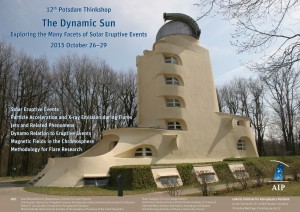Thermodynamics of Eruptive Prominences Observed During the Total Solar Eclipse of 20 March 2015
Adalbert Ding (Technische Universität Berlin and Institut für Technische Physik Berlin)
Abstract. Total solar eclipse images are snapshots of the instantaneous dynamic state of the corona. Taken over a few minutes, at best, they reveal bewildering details in coronal structures spanning several solar radii above the solar surface. At present, they are the only observations that can probe this distance range, where the magnetized coronal plasma undergoes its most pronounced evolution as it expands into interplanetary space. Spectroscopic measurements add a new physical dimension to imaging by investigating the physical properties of minor ions. During the total solar eclipse of 20 March 2015, coronal observations were made using a high-resolution dual-channel optical spectrometer, covering wavelength intervals of 15 nm centered on the Fe XIV 530 nm line and the Fe XI 789 nm line respectively. The instrument geometry and high throughput (F/4) enabled a two-dimensional scan of the corona covering an area of 5 solar radii in the north-south direction, and 2 radii in the east-west direction. Emission from hot coronal ions and from cool chromospheric singly ionized atoms have been observed within the two channels. Projected speeds of more than 1000 km/s, and temperatures around 2 MK were derived from their Doppler shifts and Doppler broadening, respectively. These could be assigned to coronal structures identified in high resolution white light images taken simultaneously during the eclipse. The Doppler measurements captured several dynamic events in different sections of a CME-like structure with a prominence at its core, over a distance span of one radius above the limb. These were correlated with very rapid prominence eruptions accompanied with their complex 2 MK shrouds away from the Sun. The combination of spectroscopic observations with imaging underscore the uniqueness and richness of the diagnostic potentials of the visible wavelength range for exploring the physics and thermodynamics of the coronal plasma.
Contributed Talk

Write a comment Close comment form